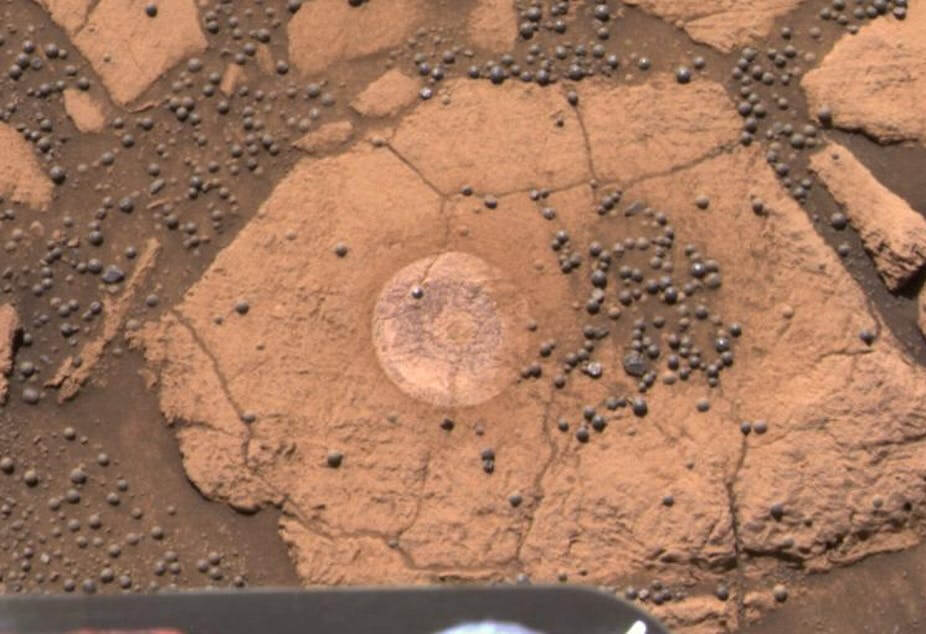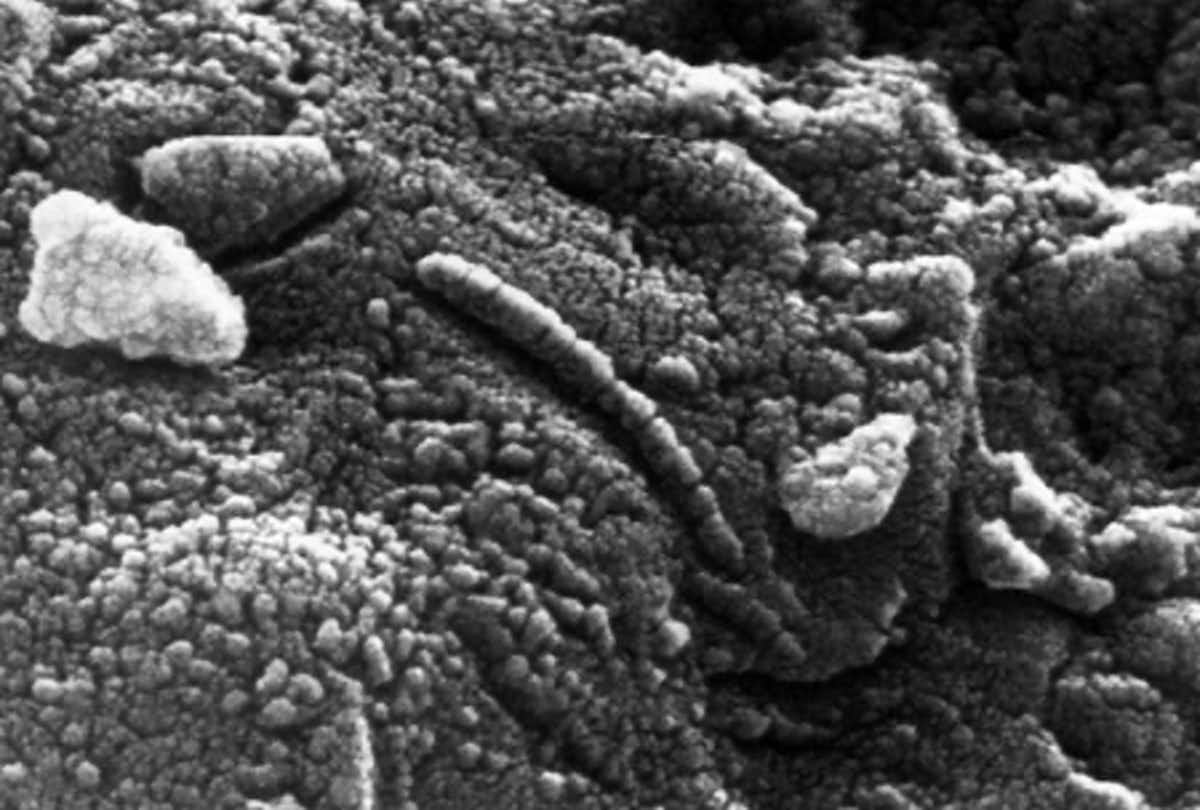During the space age, UFO enthusiasts tried to find clues to the existence of alien life in photographs or random radio signals. What to do when you come across such an argument?

By Gareth Dorrian, Postdoctoral Research Fellow in Space Sciences, University of Birmingham. Translation: Avi Blizovsky
A recent study claims to have found evidence of mushroom-like life forms on the surface of Mars. As it happens, these particular features were spotted by cameras on board NASA's Mars rover Opportunity shortly after it landed in 2004.
In fact, they are not living organisms at all, but "hematite concrete" - small ball-shaped pieces of the mineral hematite, and the researchers have not yet decided on the question of their exact origin. Hematite is a compound of iron and oxygen and is commercially important on Earth. The spherical rocks on Mars were probably formed by the gradual accumulation of the material in slowly evaporating liquid water environments. They can also be formed by volcanic activity.
Either way, mushrooms are not. The area around the landing site of Opportunity is littered with them - you can see them on the surface and they were also found buried underground and even embedded in rocks.
Fossil worms
These space "mushrooms" were not the first claim to the discovery of aliens. On August 7, 1996, then US President Bill Clinton stood on the White House lawn and announced the possibility that scientists had discovered ancient, fossilized remains of micro-organisms in a meteorite that landed in Antarctica in 1984.
The meteorite, ALH 84001, is one of the handful of Martian rocks that we have. These rocks were spread over the surface of Mars by volcanic eruptions or meteorite impacts, drifting through space probably for millions of years, before reaching Earth.

The tiny structures discovered inside them, using powerful microscopes, resemble microscopic worm-like organisms and may be billions of years old. The debate over the true origins of these structures continues today. Many scientists have noted that known inorganic processes are capable of producing structures that resemble living organisms. In other words, just because something may look a little like life (mushrooms or something), that doesn't mean it actually is.
Mysterious gases
In the seventies of the twentieth century, NASA's Viking spacecraft landed on Mars and conducted a series of experiments designed to look for the presence of microorganisms on the Martian soil.
As part of the series of experiments, a chemical test was performed on the samples taken from the Martian soil in reaction cells on board the landers. In one of the experiments, materials containing radioactive carbon-14 were discovered in the soil samples. According to the claim, these particles should be formed in the body of bacteria.
After the chemical analyses, each soil sample was steadily heated to hundreds of degrees to destroy all the bacteria, with the intention of seeing if these reactions in the soil stopped. Interestingly, this experiment did show a steady increase in carbon-14 over time that did stop after heating above the boiling point of water. Some inorganic chemical reactions have been suggested as an explanation. These results therefore remain unequivocal to this day.
Recently, tiny amounts of methane have been found in the Martian atmosphere. The finding is also intriguing because organisms living on Earth are known to release methane. However, it must be emphasized again that this is not a definitive proof of the existence of life. Methane can also be produced by some inorganic processes, including heated rocks.
An unusual radio signal
In 1977, the Big Ear radio telescope in the US detected an unusual radio signal while scanning the sky. The signal lasted only a few minutes, was very active and was detected in a narrow frequency range. These factors make it quite difficult to predict a natural cause, since most natural radio sources can be detected in a wide range of frequencies. The exact signal has not been picked up again since, despite frequent radio surveys of that part of the sky. The signal was so amazing at the time that the astronomer on duty, Jerry Ehman, circled the printout of the signal with a red pen and wrote "Wow!" next to the graph representing the discovery.
Over the years, various explanations have been proposed, including recently, that the signal was created by a passing comet, or transmissions from a satellite orbiting the Earth. The exact source of the "Wow!" of the letter is still not fully agreed upon and remains an intriguing mystery.
Tabby's star
A key tool for planet hunting is the dimming method - watching the light from a star to see if it periodically dims in a regular pattern as a planet passes in front of it. In 2015, professional astronomers working with citizen scientists from the Planet Hunter Project announced the discovery of a nearby star exhibiting unusually strong and consistent dimming over time.
Tabby's star is named after astronomer Tabitha Boyajian, who was the lead author of the paper announcing the discovery. Data from the Kepler space telescope showed not only a constant dimming, as would be expected from a planetary orbit, but irregular drops in the amount of light and a consistent decrease in light output over several years.
This unusual behavior has prompted many hypotheses to explain the observations, including planetary dust or debris from a massive impact that gradually spread to cover the surface of the star. Some also speculated that these were signs of the existence of an advanced alien species that had built a structure around the star. But in further observations no evidence was found to support this possibility. For example, radio telescopes have failed to detect unusual radio emission from the star. Today, the scientists behind the discovery believe that the abnormal decreases in the amount of light are caused by clouds of cosmic dust passing between us and the star.
Despite the great excitement in view of the observations, it is important to treat claims about the discovery of extraterrestrial life with a healthy dose of skepticism, and this is indeed what scientists do. No conclusive evidence has been found that extraterrestrial life exists...yet.
to the article on The Conversation website
More of the topic in Hayadan:

8 תגובות
we shall wait for Elon to tell us…
https://geniuses.club/genius/elon-musk
Thanks for the comment. Really confusing. In any case, I read the explanation of the Academy of Sciences and corrected it.
For some reason I thought that Uot was female because of the plural Uot (signs and examples from the Passover Haggadah), but it is known that in many periods the writers did not really know Hebrew and that is why there are many cases where there is no connection between the singular form and the plural form.
my father
For those who don't know: how do you use your logic regarding the process of creating life, a process for which there is no clear knowledge regarding the chances of its occurrence?
And what about Venus with the discovery(?) of phosphine in its atmosphere, which was mentioned not so long ago in "Yaden" itself?
https://www.hayadan.org.il/%d7%94%d7%90%d7%9d-%d7%94%d7%aa%d7%92%d7%9c%d7%94-%d7%a1%d7%9e%d7%9f-%d7%9b%d7%99%d7%9e%d7%99-%d7%9c%d7%90%d7%a4%d7%a9%d7%a8%d7%95%d7%aa-%d7%a9%d7%9c-%d7%97%d7%99%d7%99%d7%9d-%d7%a2%d7%9c-%d7%a4%d7%a0
Incredible!! The Smurf Village is found!!
Science will do everything to disprove any claim of extraterrestrial life. You are embarrassing yourselves. Just because of logic, there is no way there is no other life.
Radio signal: signal is a masculine word.
Only letters that make up words are a feminine word, a letter meaning letter/sign (like a radio signal) is a masculine word.
Radio signal: signal is a masculine word.
Only letters that make up words are a feminine word, a letter meaning just a sign is a masculine word.